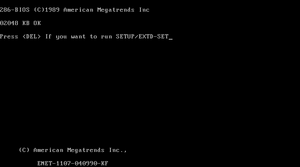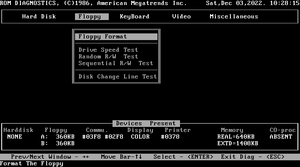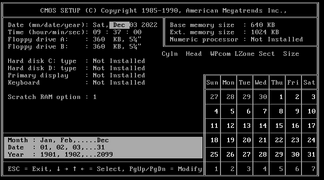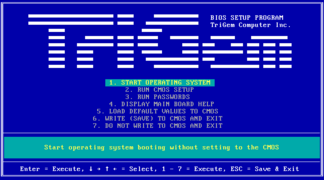No edit summary |
No edit summary |
||
| (2 intermediate revisions by the same user not shown) | |||
| Line 1: | Line 1: | ||
[[File:AMI Plus BIOS POST.png|thumb|POST screen for AMI Plus BIOS]] | [[File:AMI Plus BIOS POST.png|thumb|POST screen for AMI Plus BIOS]] | ||
AMI Plus BIOS, | AMI Plus BIOS, also unofficially nicknamed "AMI Pre-Color BIOS" since it predates [[AMI Hi-Flex BIOS]] (first version with a colourful setup utility), is a version of [[AMIBIOS]] released by [[American Megatrends]] in 1987. It is the earliest version of AMIBIOS that includes a built-in setup utility for configuring the CMOS settings without booting into a separate floppy disk containing the utility. | ||
It was also the first and only version of AMIBIOS to include a built-in system diagnostics program, a limited version of AMIDIAG specifically, although not always. Instances with built-in AMIDIAG often use "D" or "DE" for the CMOS setup type section in the BIOS string (see the [[#BIOS string|BIOS string]] section). | |||
== Setup | == Setup utility == | ||
Early releases of AMI Plus BIOS included a limited, quirky setup utility which displays all settings one-by-one (with the setup exit prompt being displayed last) and requires a value to be entered for each of them, instead of displaying all of them at once and giving the user the ability to navigate between them (so just the specific required changes can be made quickly). Because of this, to change a specific setting, the user has to review or change all settings, which makes using it less convenient and slower. At some later point, this quirky setup utility was replaced with a new one that displays all settings at once and allows the user to navigate between them so just the required changes can be made without reviewing all settings. | |||
Some motherboard manufacturers (like PC Chips and TriGem) used their own setup utility program with Plus BIOS. These are different from the default utilities included by AMI. | |||
<gallery mode="packed"> | <gallery mode="packed"> | ||
File:AMI Plus BIOS early setup utility.png|Early setup utility | |||
File:AMI Plus BIOS new setup.png|Late setup utility | |||
File:AMI Plus BIOS PC Chips setup.png|PC Chips setup | |||
File:TriGem AMI Plus BIOS setup.png|TriGem setup | |||
</gallery> | </gallery> | ||
| Line 17: | Line 19: | ||
''Main page: [[AMIDIAG]]'' | ''Main page: [[AMIDIAG]]'' | ||
AMIDIAG | AMIDIAG is a system diagnostics utility developed by American Megatrends for DOS based operating systems. The version included with some instances of Plus BIOS is a limited version compared to the actual full version of it. | ||
The following diagnostics are included with the limited Plus BIOS | The following diagnostics are included with the limited version included with Plus BIOS: | ||
'''Hard Disk''' | '''Hard Disk''' | ||
| Line 27: | Line 29: | ||
*Hard disk format | *Hard disk format | ||
*Automatic interleave | *Automatic interleave | ||
*Locate | *Locate and mark bad sectors ("Media analysis") | ||
*Performance test | *Performance test | ||
*Seek test | *Seek test | ||
*Read/verify test | *Read/verify test | ||
*Cylinder read/write test (Check test cyl.) | *Cylinder read/write test ("Check test cyl.") | ||
*List bad tracks (Force bad tracks) | *List bad tracks ("Force bad tracks") | ||
'''Floppy''' | '''Floppy''' | ||
| Line 63: | Line 65: | ||
== Technical limitations == | == Technical limitations == | ||
== BIOS string == | === Maximum storage size limit === | ||
AMI Plus BIOS also introduced a new 16/17-character | While the default setup utilities included with Plus BIOS support inputting the necessary configuration values for storage devices up to 32 GB in size, in most cases only up to 504 MB of this size can actually be used. This is due to lack of LBA (Logical Block Addressing) support in all versions of Plus BIOS (excluding some instances of the TriGem code fork). | ||
Various workarounds also exist for this limitation, such as using BIOS storage overlay utilities like Ontrack Disk Manager to use larger storage devices up to 32 GB. | |||
== Identification string == | |||
AMI Plus BIOS also introduced a new 16/17-character identification string, different from the older format used with [[AMIBIOS 2.2x]]. The first (or on 17 character strings, first two) character of the string indicates the CMOS setup type. D indicates built-in AMIDIAG diagnostics, E indicates no AMIDIAG but extended CMOS setup, S indicates no AMIDIAG or extended setup (standard setup only). "DE" was also occassionally used (for 17 character strings), indicating both built-in AMIDIAG and extended CMOS setup are available. | |||
The new string is formatted as the following: | The new string is formatted as the following: | ||
| Line 74: | Line 80: | ||
<code>DCCC-MMMM-SSSSSS-KK</code> | <code>DCCC-MMMM-SSSSSS-KK</code> | ||
'''Note:''' As stated above, occasionally 17 character strings (instead of 16) were also used, where one extra character is used | '''Note:''' As stated above, occasionally 17 character strings (instead of 16) were also used, where one extra character is used to indicate the CMOS setup type "DE" (for built-in AMIDIAG diagnostics and extended CMOS setup) | ||
'''Example string''': D286-1277-043089-K0 | '''Example string''': D286-1277-043089-K0 | ||
This string is for a 04/30/89 (April 30, 1989; date is in American format) dated | This string is for a 04/30/89 (April 30, 1989; date is in American format) dated revision AMI Plus BIOS with regular CMOS setup and built-in diagnostics ("D") for a machine with a discrete i286 logic ("286") and a default/unknown keyboard controller (K"0") for Trangg Bow Co. ("1277"). | ||
The manufacturer, chipset and keyboard controller codes can be found [[Document:AMIBIOS string codes|here.]] | The manufacturer, chipset and keyboard controller codes can be found [[Document:AMIBIOS string codes|here.]] | ||
Latest revision as of 08:11, 30 April 2024

AMI Plus BIOS, also unofficially nicknamed "AMI Pre-Color BIOS" since it predates AMI Hi-Flex BIOS (first version with a colourful setup utility), is a version of AMIBIOS released by American Megatrends in 1987. It is the earliest version of AMIBIOS that includes a built-in setup utility for configuring the CMOS settings without booting into a separate floppy disk containing the utility.
It was also the first and only version of AMIBIOS to include a built-in system diagnostics program, a limited version of AMIDIAG specifically, although not always. Instances with built-in AMIDIAG often use "D" or "DE" for the CMOS setup type section in the BIOS string (see the BIOS string section).
Setup utility
Early releases of AMI Plus BIOS included a limited, quirky setup utility which displays all settings one-by-one (with the setup exit prompt being displayed last) and requires a value to be entered for each of them, instead of displaying all of them at once and giving the user the ability to navigate between them (so just the specific required changes can be made quickly). Because of this, to change a specific setting, the user has to review or change all settings, which makes using it less convenient and slower. At some later point, this quirky setup utility was replaced with a new one that displays all settings at once and allows the user to navigate between them so just the required changes can be made without reviewing all settings.
Some motherboard manufacturers (like PC Chips and TriGem) used their own setup utility program with Plus BIOS. These are different from the default utilities included by AMI.
-
Early setup utility
-
Late setup utility
-
PC Chips setup
-
TriGem setup
AMIDIAG

Main page: AMIDIAG
AMIDIAG is a system diagnostics utility developed by American Megatrends for DOS based operating systems. The version included with some instances of Plus BIOS is a limited version compared to the actual full version of it.
The following diagnostics are included with the limited version included with Plus BIOS:
Hard Disk
Note: Hard disk diagnostics are only accessible when a hard disk is detected in AMIDIAG.
- Hard disk format
- Automatic interleave
- Locate and mark bad sectors ("Media analysis")
- Performance test
- Seek test
- Read/verify test
- Cylinder read/write test ("Check test cyl.")
- List bad tracks ("Force bad tracks")
Floppy
- Floppy format
- Drive speed test
- Random read and write test
- Disk change line test
Keyboard
- Scan/ASCII code test
Video
- Sync test
- Adapter test
- Attribute test
- 80x25 display test
- 40x25 display test
- 320x200 graphics test
- 640x200 graphics test
- Page selection test
- Colour test
Miscellaneous
- Printer adapter test
- Communication adapter test
Technical limitations
Maximum storage size limit
While the default setup utilities included with Plus BIOS support inputting the necessary configuration values for storage devices up to 32 GB in size, in most cases only up to 504 MB of this size can actually be used. This is due to lack of LBA (Logical Block Addressing) support in all versions of Plus BIOS (excluding some instances of the TriGem code fork).
Various workarounds also exist for this limitation, such as using BIOS storage overlay utilities like Ontrack Disk Manager to use larger storage devices up to 32 GB.
Identification string
AMI Plus BIOS also introduced a new 16/17-character identification string, different from the older format used with AMIBIOS 2.2x. The first (or on 17 character strings, first two) character of the string indicates the CMOS setup type. D indicates built-in AMIDIAG diagnostics, E indicates no AMIDIAG but extended CMOS setup, S indicates no AMIDIAG or extended setup (standard setup only). "DE" was also occassionally used (for 17 character strings), indicating both built-in AMIDIAG and extended CMOS setup are available.
The new string is formatted as the following:
D: CMOS setup type, CCC: Chipset type, MMMM: Manufacturer/OEM identification code, SSSSSS: BIOS subcore release date, KK: Keyboard controller (KBC) ID (with second character indicating the model).
DCCC-MMMM-SSSSSS-KK
Note: As stated above, occasionally 17 character strings (instead of 16) were also used, where one extra character is used to indicate the CMOS setup type "DE" (for built-in AMIDIAG diagnostics and extended CMOS setup)
Example string: D286-1277-043089-K0
This string is for a 04/30/89 (April 30, 1989; date is in American format) dated revision AMI Plus BIOS with regular CMOS setup and built-in diagnostics ("D") for a machine with a discrete i286 logic ("286") and a default/unknown keyboard controller (K"0") for Trangg Bow Co. ("1277").
The manufacturer, chipset and keyboard controller codes can be found here.



